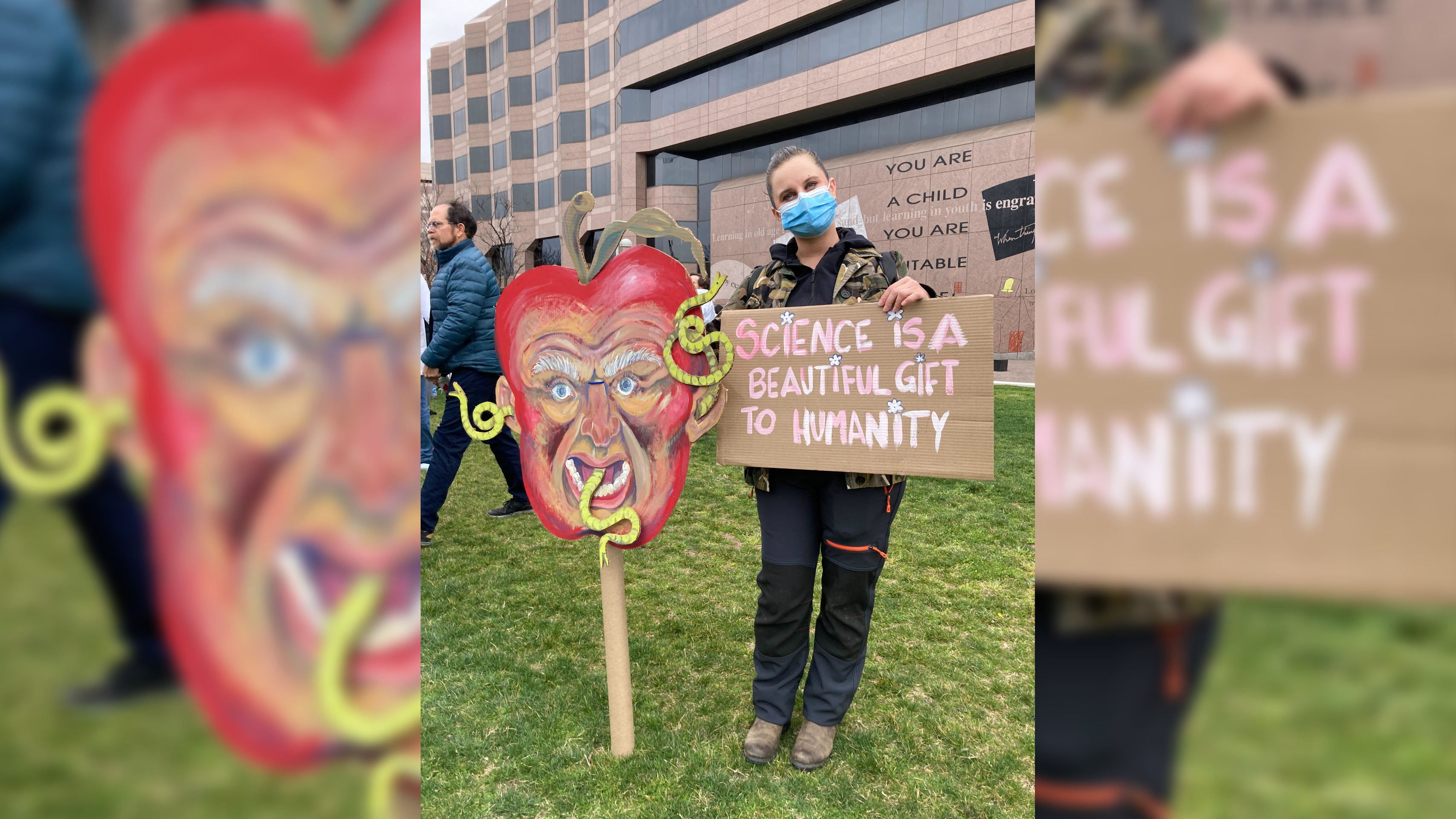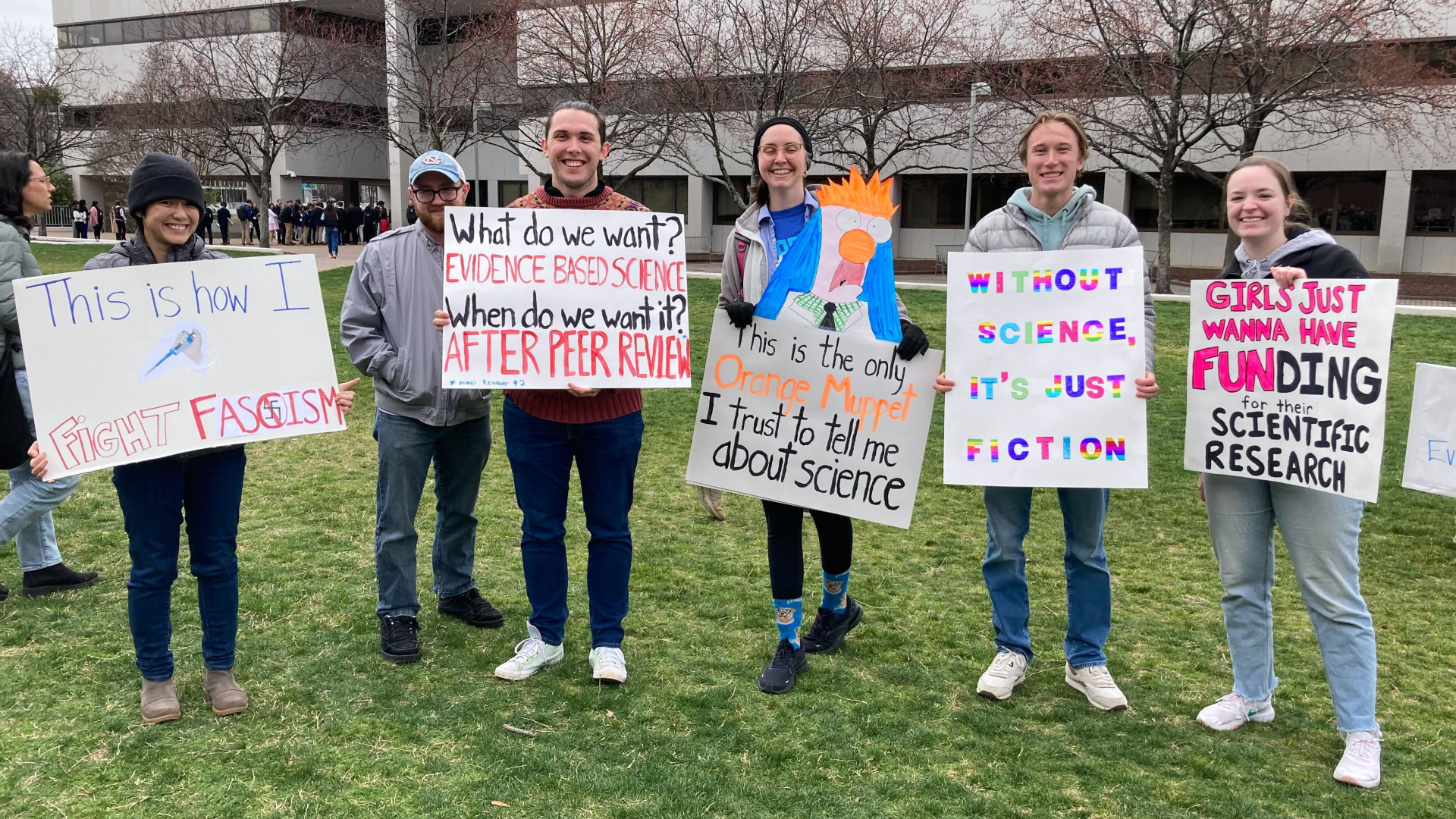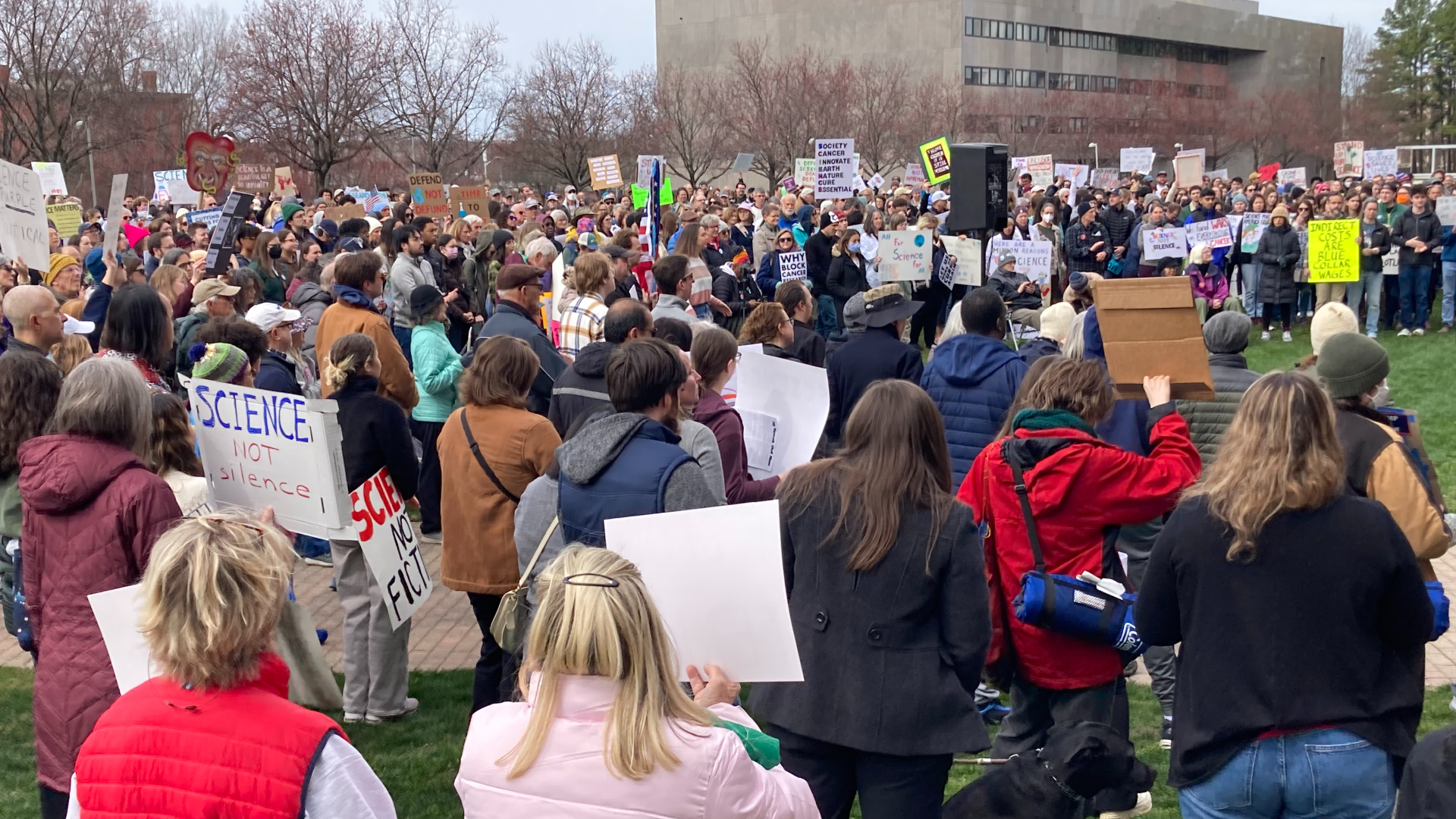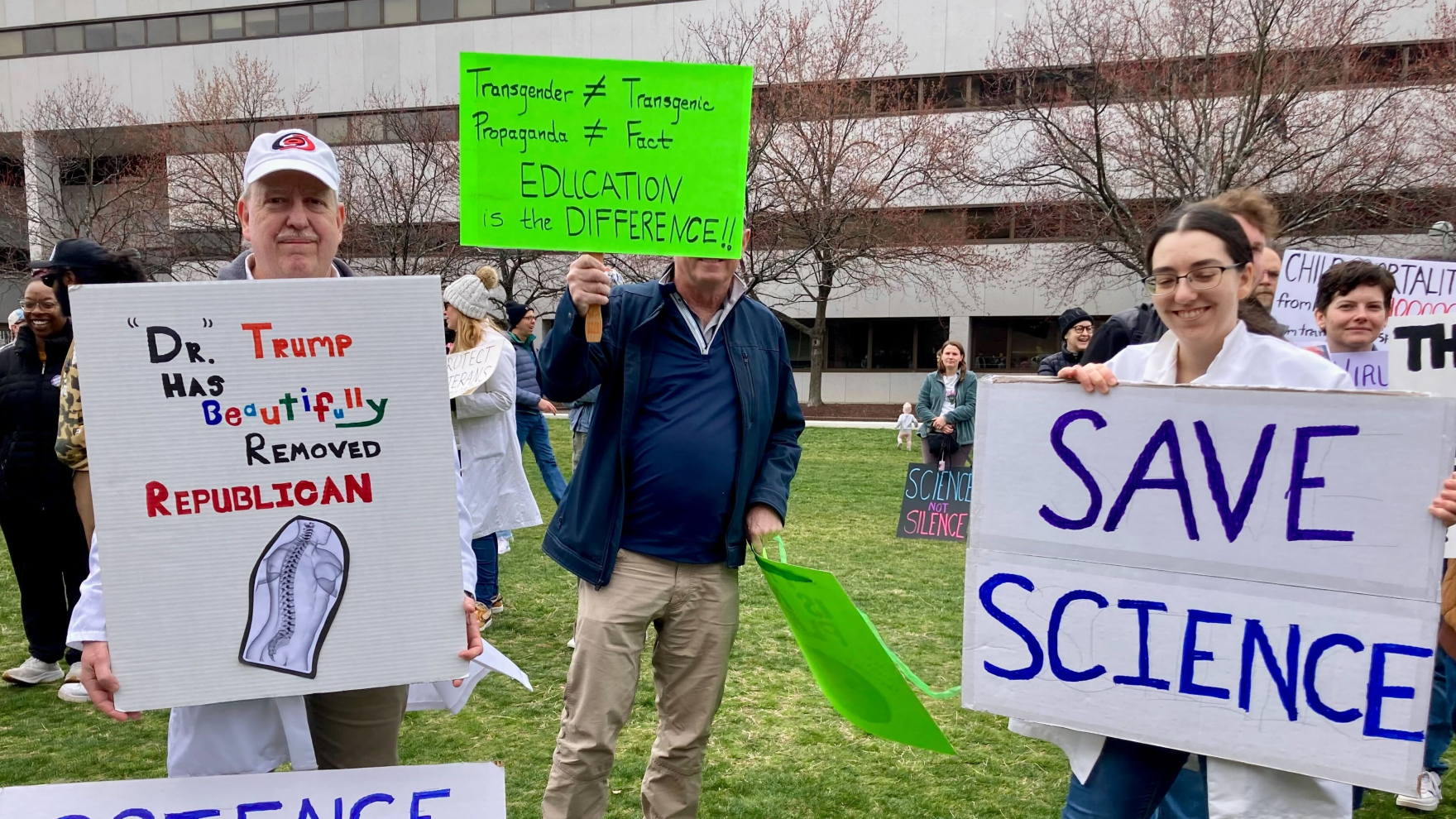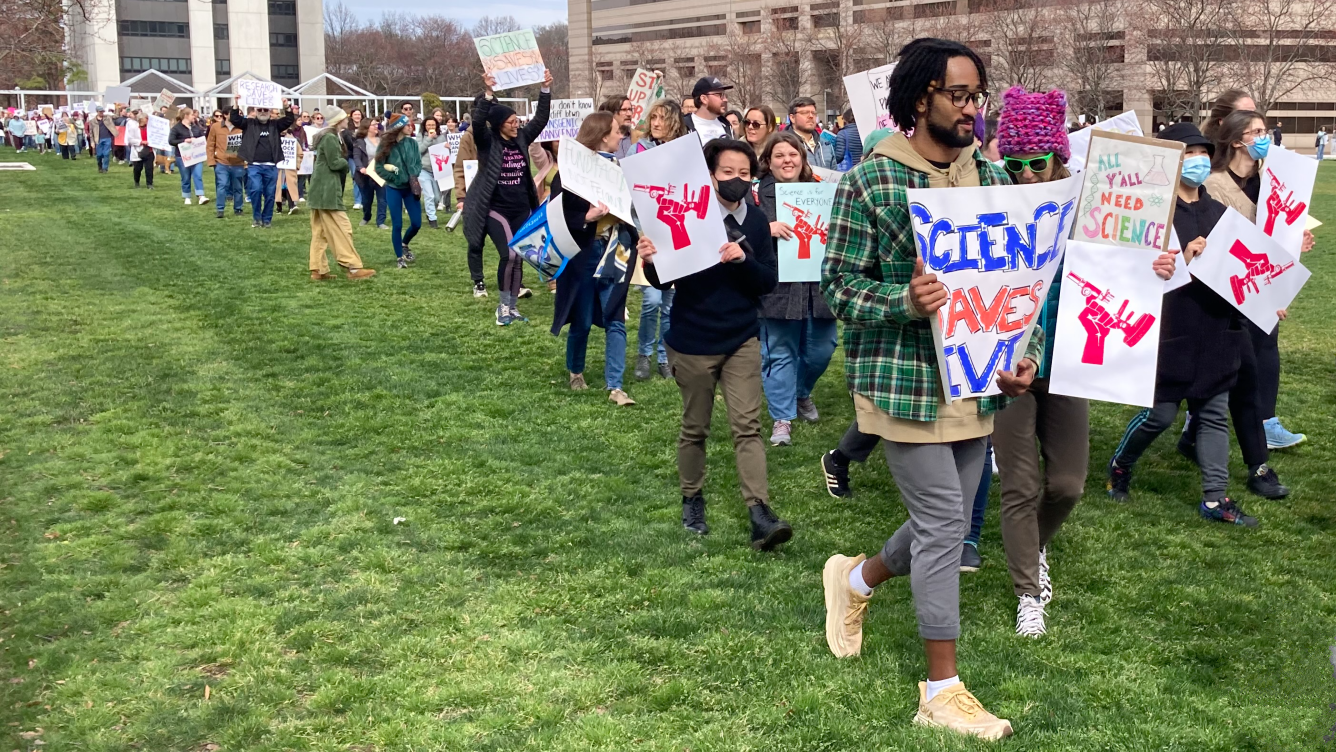Since the inauguration of President Donald Trump on Jan. 20, a number of actions aimed at slashing federal science spending and restricting research topics have begun to worry the American scientific community.
These include firing many — then rehiring some — staff across major science agencies, as well as holding up over a billion dollars in federal funding and triggering a pause in graduate admissions and faculty job postings at universities. Executive orders prompted the flagging of research projects for review based on whether they contain words like “female” or “gender,” and scrubbing peer-reviewed papers from agency websites if they conflict with the current administration’s policy priorities.
In response, scientists have begun to mobilize. On her Bluesky feed, Colette Delawalla, a graduate student in clinical psychology at Emory University in Atlanta, posted on Feb. 9 simply, “Get in Dorks, we are going protesting.”
Delawalla is the lead organizer of Stand Up for Science, a grassroots movement with three main policy goals: to end political interference in science, to secure science funding, and to defend diversity, equity, inclusion and accessibility in science.
Related: Trump executive order calls mental health prescriptions a ‘threat’ — why?
On Friday (March 7), people in more than two dozen cities across the U.S. attended Stand Up for Science rallies. The main rally was held in D.C., with speakers like Bill Nye slated to talk, and 31 other cities held their own events.
Live Science reported from two of these locations — New York City and Raleigh, North Carolina — to learn more about what science supporters want from the U.S. government.
In New York City
Hundreds of rally attendees assembled in Washington Square Park in Manhattan under a bright-blue sky, although they occasionally had to grasp their signs tightly as they were buffeted by gusts of strong wind.
The crowd represented a wide range of age groups and vocations. Young children teetered on their caregivers’ shoulders, high schoolers hoisted homemade cardboard signs, members of professional groups crowded together for a group photo in front of the square’s iconic arch, and prominent professors stood alongside members of state government.
Among the clever and emphatic signage was the giant head of the beloved Muppets character Beaker, worn by an attendee affiliated with the Zuckerman Institute at Columbia University.
Although many attendees were scientists, not all were.
“I think all expertise is under attack. That’s really why I’m here,” said Randi from Brooklyn, a retiree who previously worked in construction and asked that her last name not be used. “When you undermine expertise, then nobody knows what the facts are.” She said she “had to come out” to the event after she heard that the Centers for Disease Control and Prevention was telling scientists to scrub their research papers of “words that might cause trouble.”
“I think they’re going after experts of all kinds, trying to bankrupt them so that eventually functions that scientists do will all be privatized,” Randi told Live Science.
Two young attendees, Caitlin and Amalia, who declined to give their last names, held up signs reading, “Science is for everyone” and “Girls just wanna have fun-ding for research.” In regard to the recent developments in the federal government, Amalia, a high-school senior who plans to major in biology in college, said, “I’m just kind of in awe — shock — that this is all going on.”
Among the medical providers in attendance was Dr. Michelle Ng Gong, secretary of the American Thoracic Society (ATS), a medical society dedicated to accelerating the advancement of global respiratory health. The work of ATS is aimed at preserving lung health, in terms of both caring for patients and understanding factors that affect lung health, such as climate change and pollution, Gong said.
Cutting National Institutes of Health (NIH) funding for diverse research teams and studies that aim to meet the needs of all patients is “basically gambling on our futures,” she emphasized.
“Scientists have always tried to speak through our work, and our publications,” she added. “But now I think we need to do a better job of communicating overall the impact that science has on day-to-day life.”
That point was driven home by the chant “Science, not silence,” which the crowd called out between the speakers featured at the rally. When asked to raise their hands if their work relies on federal research funding, the majority of the crowd reached to the sky.
Among the formal speakers at the rally was Dr. Claire Pomeroy, president and CEO of the Lasker Foundation, which gives out the coveted Lasker Awards for biomedical research. She spoke of her experience during the HIV/AIDS epidemic, when she couldn’t offer patients solutions; she could only hold their hands and attend their funerals. Science changed that — now, people with HIV can lead long, prosperous lives, and the infection can be prevented with powerful medications.
Attacks on science put those kinds of breakthroughs in jeopardy, Pomeroy emphasized. She encouraged those gathered to stay informed and keep their networks outside science in the loop, as well. “We have to spread the message beyond this crowd,” Pomeroy said.
Josh Dubnau, a Stony Brook University professor who studies ALS and other neurodegenerative disorders, underscored the wide range of jobs that NIH funding supports — tens of thousands of jobs in New York State, alone, he said. He called the funding cuts and firings orchestrated by the Department of Government Efficiency (DOGE) and other federal actors a “planned and coordinated assault” on science, as well as on America’s education system.
Dubnau urged the rally attendees to band together in response, not stay silent in an attempt at self preservation.
Additional speakers included Griffin Gowdy, a biomedical researcher with Scientists Rebellion, a collective calling for action to address the climate crisis, who encouraged attendees to start or join organizations assembling on behalf of the scientific enterprise.
“Like a burning Tesla battery that not even Poiseden himself could put out, we will never stop fighting for what’s right,” Gowdy quipped.
Several New York politicians also stepped to the microphone, including state Assemblymember Harvey Epstein and state Sen. Brad Hoylman-Sigal.
Epstein, who also teaches an environmental law clinic at CUNY Law School, acknowledged there will be cuts to federal funding but called on the crowd to collectively stand up to “bullies in the White House” despite that.
Hoylman-Sigal condemned Department of Health and Human Services Secretary Robert F. Kennedy Jr. for claiming measles can be cured with vitamin A and fish oil amid the ongoing outbreak in Texas and said it’s “not right” that anyone is dying from vaccine-preventable diseases.
To conclude his talk, Hoylman-Sigal also thanked scientists for their role in making it so that HIV is no longer a death sentence; as a gay man, Hoylman-Sigal was grateful for the lives HIV drugs have spared within the LGBTQ+ community.
In Raleigh
A crowd of around 500 people gathered slowly but steadily on Halifax Mall, a block from the state capitol building and the North Carolina Museum of Natural Sciences. A stiff wind blew posters willy-nilly as people listened to speakers, including Jamie Vernon, the executive director of Sigma Xi, the scientific honor society headquartered in North Carolina’s “Research Triangle.”
Protest leaders encouraged the gathering of young, mid-career and retired scientists and supporters to take occasional “warm-up breaks” while chanting phrases like “What do we want? Science! When do we want it? Now!” and “Vaccines are awesome, imagine if we lost ’em.”
Toxicologist Noelle Muzzy told Live Science that she organized the Raleigh Stand Up for Science rally because “in one sentence: science is under attack.”
The executive orders affecting funding, federal jobs and censorship were at the forefront for Muzzy. “All of that is limiting what we can do as researchers. That’s very concerning, not just for career scientists but also for the general public,” she said, adding that “we’re going to be losing access to new technology that could save lives and produce medical treatments as well.”
But the general tenor of the Raleigh event was optimistic, even as many signs satirized the language that President Trump and Elon Musk in particular have used recently to denigrate science they deem worthless, such as “Transgender ≠ Transgenic.”
“I’m here because I support science in every way, shape and form. Not only for myself and my colleagues personally, but for everyone because science is, in fact, for everyone,” McKenzie Gehris, a graduate student in pharmacology at the University of North Carolina at Chapel Hill, told Live Science. She had a poster of the muppet Beaker that read, “This is the only orange muppet I trust to tell me about science.”
“The research that scientists do across the country helps cure diseases, helps figure out things about our climate and the world that we live in,” Gehris said. “It’s important that we fund that sort of research.”

